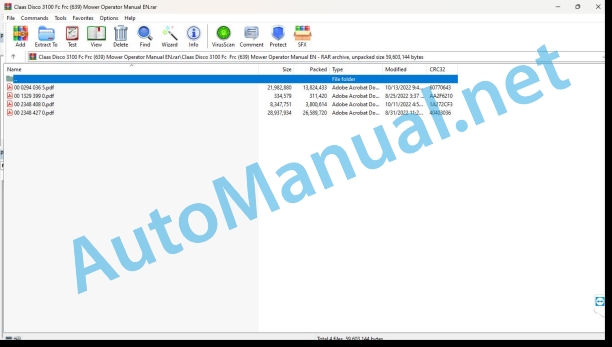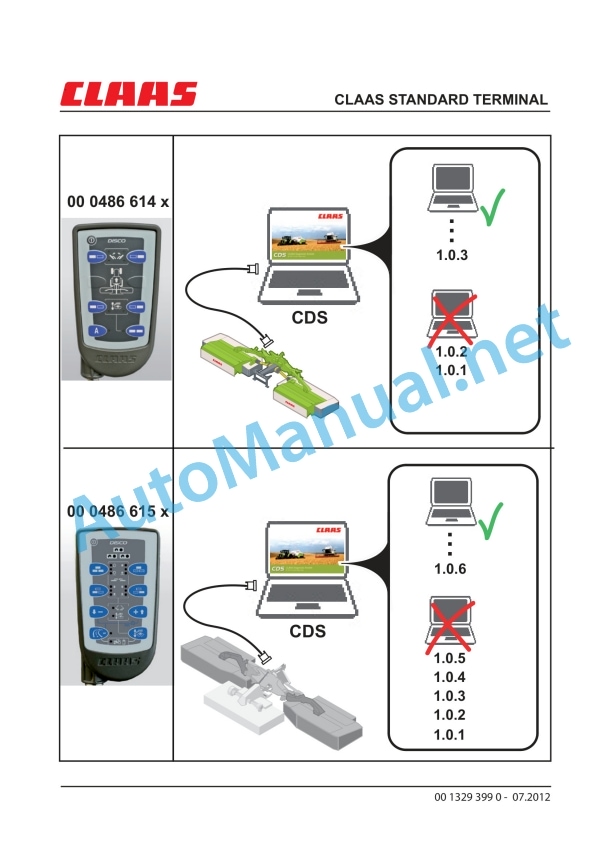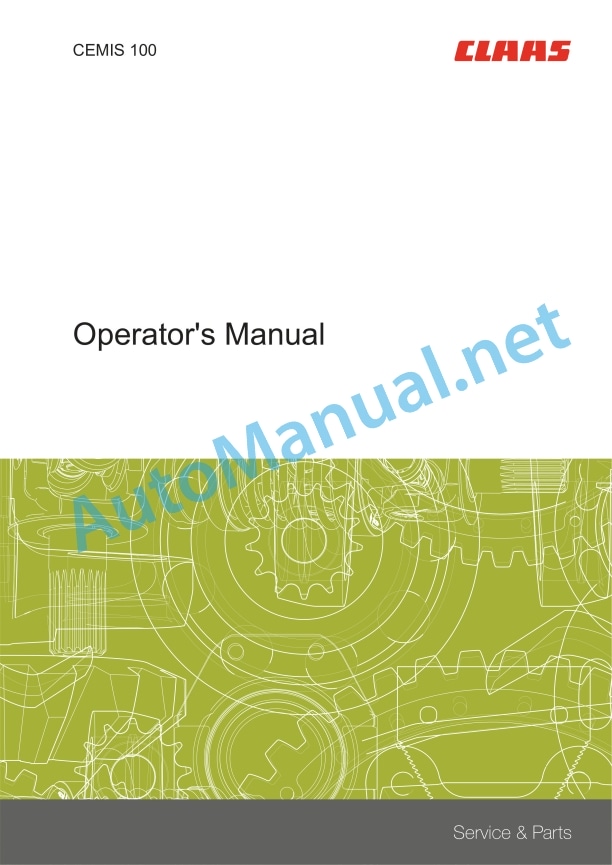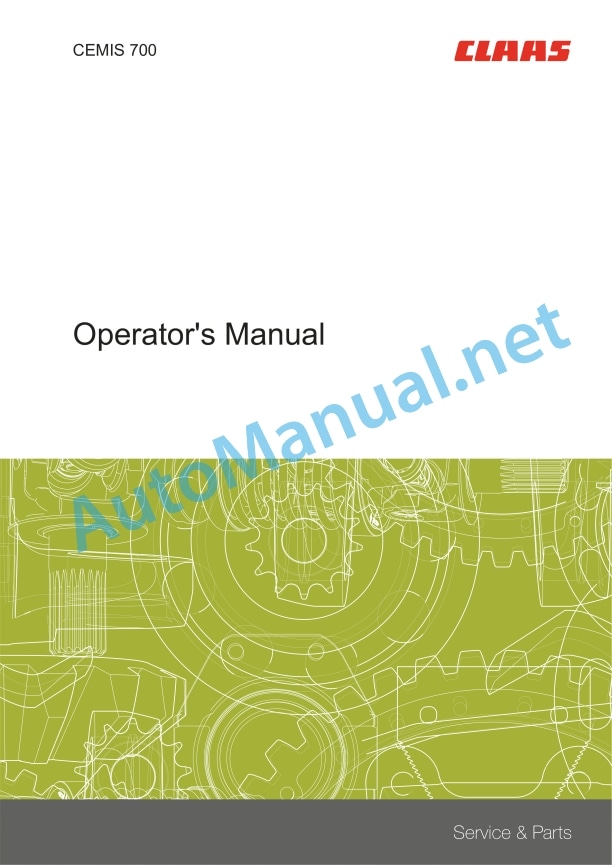Claas Disco 3100 Fc Frc (639) Mower Operator Manual EN
$50.00
- Model: Disco 3100 Fc Frc (639) Mower
- Type Of Manual: Operator Manual
- Language: EN
- Format: PDF(s)
- Size: 42.5 MB
File List:
00 0294 036 5.pdf
00 1329 399 0.pdf
00 2348 408 0.pdf
00 2348 427 0.pdf
00 0294 036 5.pdf:
DISCO 3100 F Profil
DISCO 3100 FC Profil
DISCO 3100 FRC Profil
Table of contents
1 To this operator’s manual
1.1 Notes on the manual
1.1.1 General instructions
1.1.2 Using the manual
Directions
1.1.3 Validity of manual
1.1.4 Symbols and notes
1.1.5 Technical specifications
2 Safety
2.1 Safety rules
2.1.1 Particularly important
2.1.2 Qualification of drivers and maintenance personnel
2.1.3 Intended use
2.1.4 Reasonably foreseeable misuse
2.1.5 Safety and accident prevention regulations
2.1.6 First aid measures
2.1.7 Danger of injury from hydraulic liquid
2.2 Safety decals on the machine
2.2.1 Safety decals
2.2.2 Position of hazard warning signs
3 Machine description
3.1 Overview and method of operation
3.1.1 Overview of DISCO 3100 F Profil
3.1.2 Overview of DISCO 3100 FC Profil / FRC Profil
3.1.3 Function of DISCO 3100 F Profil
3.1.4 Function of DISCO 3100 FC Profil
3.1.5 Function of DISCO 3100 FRC Profil
3.2 Optional machine equipment
3.2.1 High-cut skids
3.2.2 Low-cut skids
3.2.3 Bolted wear skids
3.2.4 Slip-on yoke for 8-piece universal drive shaft
3.2.5 Three point extension
3.2.6 Hydraulically folding safety frames
3.2.7 Hydraulic front load relief ACTIVE FLOAT“
3.2.8 Hydraulics kit – AXION 800 with 5 tons lifting unit
3.2.9 Legal equipment for France
3.3 Identification plate and vehicle identification number
3.3.1 Spare parts and technical questions
3.3.2 Position of identification plate
3.3.3 Position of identification number
3.3.4 Explanation of machine identification plate
4 Operating and control elements
4.1 Mower unit
4.1.1 Lock
4.1.2 Lock
4.2 Conditioner
4.2.1 Lever
4.2.2 Star handle
5 Technical specifications
5.1 DISCO 3100 F Profil – Type 623
5.1.1 Dimensions
5.1.2 Weights
.1.3 Requirements for the tractor
5.1.4 Version
5.1.5 Sound pressure level
5.1.6 Operating utilities and filling quantities
5.2 DISCO 3100 FC Profil – Type 639
5.2.1 Dimensions
5.2.2 Weights
5.2.3 Requirements on the tractor
5.2.4 Version
5.2.5 Sound pressure level
5.2.6 Operating utilities and filling quantities
5.3 DISCO 3100 FRC Profil – Type 639
5.3.1 Dimensions
5.3.2 Weights
5.3.3 Requirements on the tractor
5.3.4 Version
5.3.5 Sound pressure level
5.3.6 Operating utilities and filling quantities
6 Assembling the machine
6.1 DISCO 3100 F Profil – Type 623
6.1.1 Unpacking
6.1.2 Installing the left / right safety frame
6.1.3 Installing the front / rear safety frame
6.1.4 Installing the left / right safety guards
6.1.5 Installing the front / rear safety guards
6.2 DISCO 3100 FC Profil – Type 639
6.2.1 Unpacking
6.2.2 Installing the left / right safety frame
6.2.3 Installing the safety frame at the front
6.2.4 Installing the left / right safety guards
6.2.5 Installing the safety guard at the front
6.2.6 Installing the left / right swathing plates
6.2.7 Installing the baffle plates
6.2.8 Installation the rear safety guard
6.3 DISCO 3100 FRC Profil – Type 639
6.3.1 Unpacking
6.3.2 Installing the left / right safety frame
6.3.3 Installing the safety frame at the front
6.3.4 Installing the left / right safety guards
6.3.5 Installing the safety guard at the front
6.3.6 Installation the left / right swathing plates
6.3.7 Installation the rear safety guard
6.4 Knives
6.4.1 Installing the mower knives
7 Machine preparation
7.1 Adapting the tractor
7.1.1 Axle loads, minimum ballast, total weight
7.1.2 Calculating the minimum front ballast
7.1.3 Calculating the minimum rear ballast
7.1.4 Calculating the actual front axle load
7.1.5 Calculating the actual total weight
7.1.6 Calculating the actual rear axle load
7.1.7 Calculation table
7.1.8 Adjusting the front power lift
7.1.9 Attaching the three-point extension*
7.1.10 Fitting the brackets for load relief springs
7.1.11 Fitting the plates for the floatation springs
7.1.12 Bracket – fitting recommendations for floatation springs
CLAAS AXION 840
CLAAS ARES 836 RZ
CLAAS ARES 836 RZ
CLAAS ARES 696 RZ
CLAAS ARES 696 RZ
CLAAS CELTIS 446 RX
Fendt Vario Favorit 716
7.1.13 Bracket installation kits for suspension springs
CLAAS AXION 800
CLAAS ARES
CLAAS ARION 600 / 600 C / 500
CLAAS ARION 400
CLAAS AXOS
CLAAS ELIOS
CLAAS CELTIS
Fendt 900 Vario (new)
Fendt 800 Vario (new)
Fendt 800 Vario (old) / 700 Vario / 400 Vario
Fendt 309 Vario / 309 Ci / 307 Vario
Fendt 300 Vario
7.1.14 Mounting the hydraulic front load relief bracket
7.1.15 Mounting the hydraulic front load relief mounting plates
7.1.16 Recommendations for fitting the hydraulic front load relief brackets
CLAAS AXION 800
CLAAS ARION 600 / 600 C / 500
CLAAS ARION 600
CLAAS ARION 400
CLAAS AXOS 300
CLAAS ELIOS
Fendt 900 Vario (new)
Fendt 800 Vario (new)
Fendt 800 Vario (old) / 700 Vario / 400 Vario
Fendt 309 Vario / 309 Ci / 307 Vario
Fendt 300 Vario
Fendt 600 Vario (old)
7.2 Shutting down and securing the machine
7.2.1 Shutting down and securing the machine
7.2.2 Securing the lifted machine
7.3 Adapting the machine
7.3.1 Adapting to front PTO shaft rotating anti- clockwise
7.3.2 Universal drive shaft for CLAAS Celtis 446 RX
7.3.3 Universal drive shaft – Checking the length
7.3.4 Universal drive shaft – Adapting the length
7.3.5 Fitting the universal drive shaft to the machine
7.3.6 Conditioner speed
7.3.7 Adjusting the hydraulic load relief*
7.4 Hitch the machine
7.4.1 Preparing for installation
7.4.2 Accommodating the machine
7.4.3 Checking/adjusting the locking mechanism
7.4.4 Hooking in the safety guard
7.4.5 Checking the safety guard
7.4.6 Folding the lock out
7.4.7 Folding the lock out
7.4.8 Installing the universal drive shaft
7.4.9 Adjusting the upper link
7.4.10 Fitting the floatation springs
7.4.11 Fitting the hydraulic front load relief*
Checking the fitting position
7.4.12 Connecting the hydraulically folding safety frames*
7.5 Unhitching the machine
7.5.1 Folding in the lock
7.5.2 Folding in the lock
7.5.3 Detaching the safety guard
7.5.4 Unhinge the suspension springs
7.5.5 Removing the hydraulic front load relief*
7.5.6 Disconnecting the hydraulically folding safety frames*
7.5.7 Removing the universal drive shaft
7.5.8 Setting down the machine
7.6 Prepare road travel
7.6.1 Folding the safety frame up
7.6.2 Raising into transport position
7.7 Prepare field work
7.7.1 Folding the safety frame down
7.8 Loading the machine
7.8.1 Loading / unloading the machine
7.8.2 Loading / unloading the machine
8 Operation
8.1 General safety precautions
8.1.1 Prior to operation
8.2 Driving on the road
8.2.1 Road travel
8.2.2 Marking the machine for road travel
8.3 Fieldwork settings
8.3.1 Adjusting ground contour following
8.3.2 Adjusting the cutting height
8.3.3 Adjusting the tine conditioner
8.3.4 Adjusting the swath width
8.3.5 Adjusting the crop spreader
8.3.6 Mowing without conditioner effect
8.4 Fieldwork
8.4.1 Fieldwork
8.4.2 Machine use
Optimum PTO speed
8.4.3 Mowing methods
8.4.4 Instructions for mowing
8.4.5 Difficult conditions of use
8.4.6 Recommendation for environmental protection
9 Faults and remedies
9.1 Causes and remedies
9.1.1 General warnings
9.1.2 General trouble and remedy
10 Maintenance
10.1 Maintenance Information
10.1.1 General warnings
10.1.2 Electrical system
10.1.3 Protective guards
10.1.4 Spare parts
10.1.5 Unbalance
10.1.6 Compressed air and water
10.1.7 Burn prevention
10.1.8 Oils
10.1.9 Fire prevention and explosion prevention
10.1.10 Lines, tubes and hoses
10.2 Overview maintenance intervalls
10.2.1 Handling maintenance intervals
10.2.2 Before the harvest
10.2.3 After the first 50 operating hours
10.2.4 Every 8 operating hours
10.2.5 Every 20 operating hours
10.2.6 Every 100 operating hours
10.2.7 Every 250 operating hours
10.2.8 Every 500 operating hours or annually
10.2.9 As needed
10.2.10 After the harvest
10.3 Maintenance operations in general
10.3.1 Clean machine
10.3.2 Preserve the machine
10.3.3 Fastening material
10.4 Maintenance operations gearbox
10.4.1 Check gearbox tightness
10.4.2 Main gearbox
10.4.3 Main gearbox
10.4.4 Angle drive
10.5 Maintenance operations clutch
10.5.1 Adjusting the friction clutch
10.5.2 Venting the friction clutch
10.5.3 Replacing the friction discs
10.6 Maintenance operations drive shaft
10.6.1 Maintaining drive shafts
10.7 Mower unit maintenance work
10.7.1 Checking the mower head oil level
10.7.2 Changing the mower head oil
10.7.3 Removing the mower knife box
10.7.4 Observe direction of rotation of mower discs
10.7.5 Checking the knives
10.7.6 Replacing the knives
10.7.7 Checking the mower knife holder
10.7.8 Maintaining the cutting disc
10.7.9 Replacing the cutting discs
10.7.10 Installing the pinion units
10.7.11 Adjusting the anti-wrap guard
10.8 Conditioner maintenance work
10.8.1 Tensioning the drive belt
10.8.2 Changing the drive belts
10.8.3 Fitting / removing conditioner tines
10.8.4 Adjusting the roller conditioner
10.9 Swathing disc maintenance work
10.9.1 Adjusting the right swathing disc
10.10 Maintenance work on safety devices
10.10.1 Adjusting the safety device
Front safety guard holder
Left / right safety guard holder
10.11 Frame maintenance work
10.11.1 Adjusting the lock for fitting and removal
10.11.2 Adjusting ground contour following
10.11.3 Adjusting ground contour following
10.12 Lubrication chart
10.12.1 Grease points – 8 h
10.12.2 Grease points – 20 h
10.12.3 Grease points – 100 h
10.12.4 Grease points – 250 h
11 Placing out of operation and disposal
11.1 General Information
11.1.1 Removal from service and disposal
12 EC-declaration of conformity
12.1 DISCO 3100 F Profil / FC Profil / FRC Profil
12.1.1 EC Declaration of Conformity
13 Technical terms and shortcuts
13.1 Terms and explanations
13.1.1 Technical terms
13.1.2 Abbreviations
00 2348 408 0.pdf:
CEMIS 100
Table of contents
1 Introduction
1.1 General information
1.1.1 Validity of the manual
1.1.2 Information about this Operator’s Manual
1.1.3 Symbols and notes
1.2 Intended use
1.2.1 Intended use
1.2.2 Reasonably foreseeable misuse
2 Safety
2.1 Safety rules
2.1.1 General safety and accident prevention regulations
2.1.2 Interaction between terminal and machine or tractor
2.1.3 Electrocution by electrical system
3 Product description
3.1 Overview and method of operation
3.1.1 Overview of CEMIS 100
3.1.2 Function principle of CEMIS 100
3.2 Identification plates and identification numbers
3.2.1 Spare parts and technical questions
3.2.2 Identification plate of CEMIS 100
4 Operating and display elements
4.1 CEMIS 100
4.1.1 User interface for LINER
4.1.2 User interface for ROLLANT
4.1.3 User interface for UNIWRAP
5 Technical specifications
5.1 CEMIS 100
5.1.1 Specification
6 Operation
6.1 CEMIS 100
6.1.1 Operating the CEMIS 100
6.1.2 Switching CEMIS 100 on
6.1.3 Switching CEMIS 100 off
7 Maintenance
7.1 CEMIS 100
7.1.1 Daily
8 Putting out of operation and disposal
8.1 General information
8.1.1 Removal from service and disposal
9 Technical terms and abbreviations
9.1 Terms and explanations
9.1.1 Technical words
9.1.2 Abbreviations
00 2348 427 0.pdf:
CEMIS 700
Table of contents
1 Introduction
1.1 General information
1.1.1 Validity of the manual
1.1.2 Information about this Operator’s Manual
1.1.3 Symbols and notes
1.2 Intended use
1.2.1 Intended use
1.2.2 Reasonably foreseeable misuse
2 Safety
2.1 Safety rules
2.1.1 General safety and accident prevention regulations
2.1.2 Interaction between terminal and machine or tractor
2.1.3 Electrocution by electrical system
3 Product description
3.1 Overview and method of operation
3.1.1 Overview of CEMIS 700
3.1.2 Function principle of CEMIS 700
3.2 Identification plates and identification numbers
3.2.1 Spare parts and technical questions
3.2.2 Identification plate of CEMIS 700
4 Information on the product
4.1 Software version
5 Operating and display elements
5.1 CEMIS 700
5.1.1 User interface
5.1.2 Terminal program
6 Technical specifications
6.1 CEMIS 700
6.1.1 Specification
7 Operation
7.1 CEMIS 700
7.1.1 Operating the CEMIS 700
7.1.2 Switching CEMIS 700 on
7.1.3 Switching CEMIS 700 off
7.2 Terminal settings
7.2.1 Making settings
Making settings with the rotary button
Making settings with the touch function
7.2.2 Setting the screen lighting
Daytime mode
Nighttime mode
Activating automatic key lighting
7.2.3 Setting the time and date
7.2.4 Displaying diagnosis information
On-board power supply voltage display
Display of CLAAS ISOBUS ECU address and name
7.2.5 Setting the language and display formats
Setting the language
Setting display formats
7.2.6 Setting the volume
7.2.7 Deleting an ISOBUS implement
8 Maintenance
8.1 Maintenance
8.1.1 Daily
9 Putting out of operation and disposal
9.1 General information
9.1.1 Removal from service and disposal
10 Technical terms and abbreviations
10.1 Terms and explanations
10.1.1 Technical words
10.1.2 Abbreviations
John Deere Repair Technical Manual PDF
John Deere Repair Technical Manual PDF
John Deere Parts Catalog PDF
John Deere Tractors 6300, 6500, and 6600 Parts Catalog CQ26564 (29SET05) Portuguese
John Deere Repair Technical Manual PDF
John Deere Repair Technical Manual PDF
John Deere Application List Component Technical Manual CTM106819 24AUG20
John Deere Repair Technical Manual PDF
John Deere 18-Speed PST Repair Manual Component Technical Manual CTM168 10DEC07
John Deere Repair Technical Manual PDF
John Deere Repair Technical Manual PDF
John Deere Repair Technical Manual PDF
























